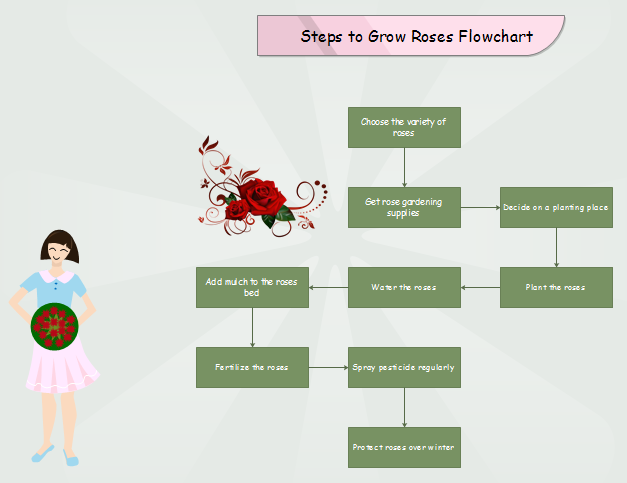Steps to Grow Roses Flowchart
Planting roses is a fun and enjoyable way to add beauty to your garden. While planting roses may seem intimidating for the beginning gardener, in fact, the process is very easy. Below you will find a grow-roses flowchart instructions on how to plant a rose bush.
The Meaning of Roses
Roses are the most popular in the flower community. Do you know different color roses have different rose meanings? Often this is overlooked when sending flowers to that special somebody. The message "I love you" is best served by sending red roses. The message "thank you" is best served by sending deep pink roses. Yellow roses are used to express your frienship. White roses are used to express your admiration for someone's purity and elegance.
Steps to Grow Roses
Choose Rose Varieties
There are over 13,000 varieties of roses. Some roses grow better in certain regions than in others. When you're choosing what type of rose to grow, take some time to research the specifics of your growing region, then look for roses that have characteristics you find appealing. Take their shape, size, and color into account when choosing varieties to grow.
Decide on a Planting Place
You'll need a place that gets at least 6 hours of good sunlight a day. Choose a place that's not crowded with the roots or branches of other plants and trees. The soil should be loose and have good drainage; if yours has a lot of clay, loosen it and add some gypsum pellets before planting.
Get Rose Gardening Suppilies
Having your roses and location is a great start, but if you want to plant the roses, then you have to get all of your materials in order. Here are what you will need: fertilizer, mulch, pruning shears, gardening gloves, compost or rose planting mix, a spade, a shovel, a filled watering pot.

Plant the Roses
Place the bare root or potted rose on top of the mound. Use a shovel to fill the hole back up with soil. The rose's bud union should be located about 2 inches below the surface of the ground. If you live in a colder region, you may need to plant your roses deeper to protect them from low temperatures. Moreover, learn how to grow healthy plants and how to grow lilies here.
Water and Fertilize the Roses
Thoroughly watering the area where you planted the rose helps compact the soil against the roots, stabilizing the plant. Make sure it gets a good soaking right after you're finished planting. After they are established, roses should be fertilized a few times per growing season. Use fertilizer in early spring, when you see the first few leaves sprout. Use it again after the first bloom, and again if there's another bloom. Stop fertilizing the roses at the end of the summer.
Spray Pesticide with Water
These aphids and spider mites are quite common among most of the rose varieties. Using water is the most effective way to get rid of these pests. Use the hose to spray them away when you see them on your rose plants. Keeping the roses adequately watered also helps reduce pest infestations.
Keep the Roses Trimmed
Pruning roses keeps them both beautiful and healthy. The goal is to clear away crowded areas to open up the bush, which helps prevent rotting and disease. The pruning strategy differs according to the season, but the cut you make is always the same: prune just above a bud eyes, the areas where branches form. They look like small circular swells and are usually located above a set of mature leaves. Make a down-slanted cut on an outward-facing bud eye.
Protect the Roses over the Winter
Roses that are left tall may be damaged by heavy winds and frosts during the winter. Trim the canes down to 2 feet. Tie them together with twine, to help protect them from inclement weather. Heap a mound of compost around the base of the bush, then top it with a layer of straw. When the weather warms to above 51 degrees, remove the compost mound.
Last but not least, when you make the home plan, office layout, house plan, building plan and garden design, it is quite important to consider a question: whether you leave enough space for the roses in your house, office and buildings, etc.
Use Flowchart to Present Ideas and Process in Daily Life
Flowchart is a popular way to present complicate ideas. Nowadays flowcharts appear frequently on blogs, social media, website pages, etc. Creatingaflowcharthasbecominganindispensabletechnologyeveryoneshouldlearntodo.WithEdraw
More Flowchart Applications
Flowchart is not limited for special fields. It can be used for many purposes. Here are some typical usages of flowchart:


